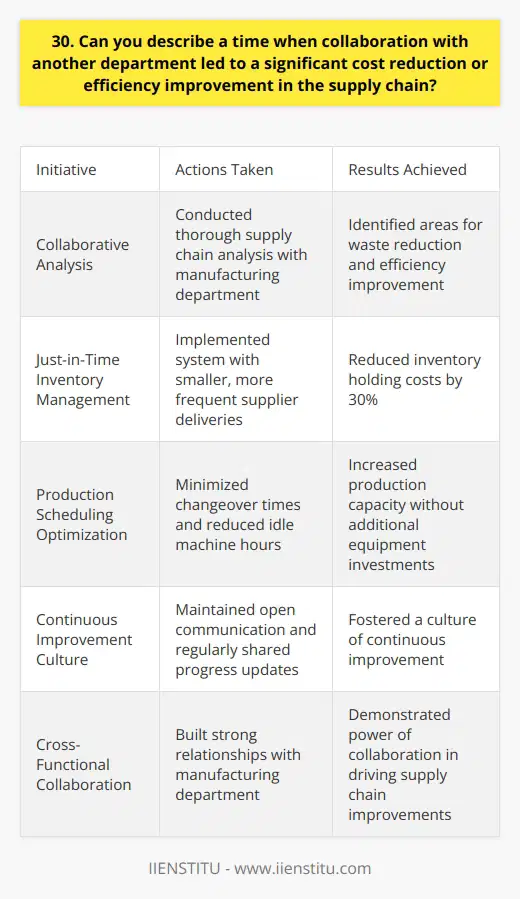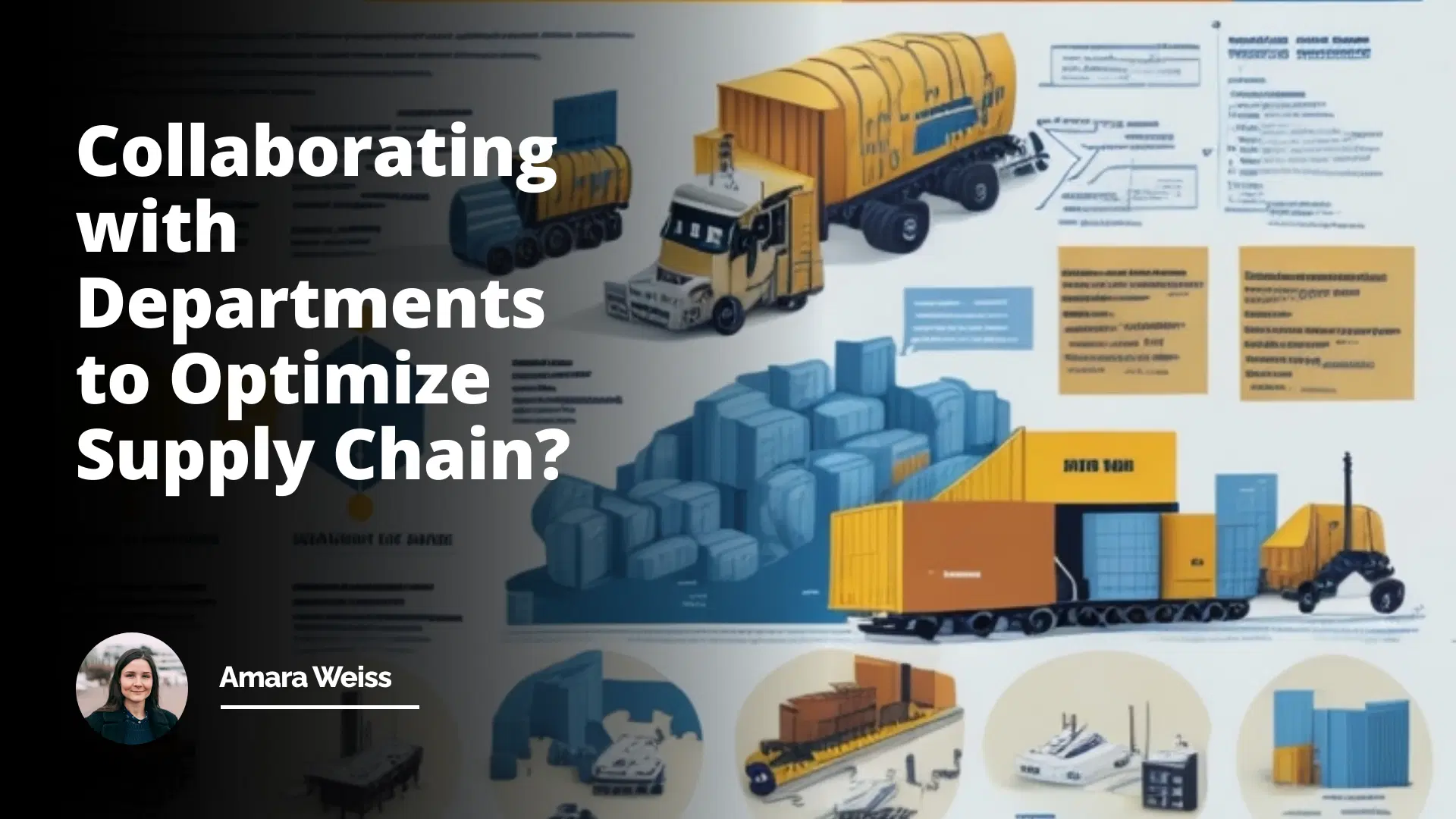
In today's fast-paced and highly competitive business landscape, organizations are constantly seeking ways to optimize their supply chain operations. One crucial aspect that often gets overlooked is the power of interdepartmental collaboration. When various departments within a company work together seamlessly, it can lead to significant improvements in supply chain efficiency, cost reduction, and overall business performance. However, fostering a collaborative culture across different functions is easier said than done. It requires a deep understanding of each department's role, effective communication strategies, and a shared vision for success.
As a supply chain professional with over a decade of experience, I have witnessed firsthand the transformative impact of cross-functional collaboration. In my previous role at a global manufacturing firm, we faced a major challenge in reducing lead times and improving customer satisfaction. Despite having a talented team of individuals, our efforts were often siloed within each department. It wasn't until we implemented a structured approach to interdepartmental collaboration that we began to see significant improvements.
One of the key strategies we employed was regular cross-functional meetings, where representatives from procurement, production, logistics, and customer service would come together to discuss challenges, share insights, and brainstorm solutions. These meetings fostered a sense of shared ownership and accountability, as each department recognized their role in the larger supply chain process. By openly communicating and aligning our goals, we were able to identify bottlenecks, streamline processes, and implement more efficient practices across the board.
Interview Question: Measuring Performance with Supply Chain KPIs
Interview Question: What's a Common Time Management Myth You Disagree With?
Another critical aspect of successful collaboration is building strong relationships and trust among departments. In my experience, this often requires stepping out of one's comfort zone and actively seeking to understand the perspectives and challenges faced by other functions. For example, I made it a point to regularly visit the production floor and engage with team members from different departments. By listening to their concerns and ideas, I gained valuable insights that helped inform our supply chain optimization strategies.
How Often Do You Reassess Your Time Management Methods İnterview Question
İnterview Question Tips For Global Digital Marketing Experience
Long Tail Keyword For Rfıd Technology İn Supply Chain Logistics
Of course, collaboration is not without its challenges. One common pitfall is the tendency for departments to prioritize their own goals and metrics over the broader organizational objectives. This can lead to conflicts, finger-pointing, and a lack of cooperation. To mitigate these risks, it's essential to establish clear roles and responsibilities, set shared performance indicators, and foster a culture of mutual respect and understanding.
In his book "The Power of Collaboration," author Morten Hansen highlights the importance of "disciplined collaboration" in driving business success. He argues that effective collaboration requires a structured approach, with clear goals, well-defined processes, and a focus on results (Hansen, 2009). This aligns with my own experience, where I've seen the most significant improvements in supply chain performance when collaboration is targeted, measured, and continuously refined.
Another valuable resource is the research conducted by the Global Supply Chain Institute at the University of Tennessee. In their white paper "Creating a Collaborative Supply Chain," they emphasize the role of leadership in driving collaboration, noting that "the most successful supply chain leaders are those who can build and maintain strong relationships across functions and organizations" (Autry et al., 2015, p. 3). This underscores the importance of developing collaborative skills and mindsets at all levels of the organization, from frontline workers to senior executives.
So, what are some practical steps that companies can take to foster interdepartmental collaboration in supply chain management? Here are a few key recommendations:
How can we cooperate with different departments to enhance our supply chain?
In what way can collaboration between departments optimize the supply chain?
Could collaboration with various departments improve our supply chain optimizing efforts?
How does a departmental collaborative approach benefit the supply chain optimization?
What role does inter-departmental collaboration play in supply chain optimization?
How significant is departmental cooperation in the process of optimizing a supply chain?
Does collaborating with departments simplify the process of supply chain optimization?
What are your thoughts on partnering with different departments for supply chain optimization?
How does cross-department collaboration influence the efficiency of our supply chain?
What is the impact of interdepartmental collaboration on supply chain improvement?
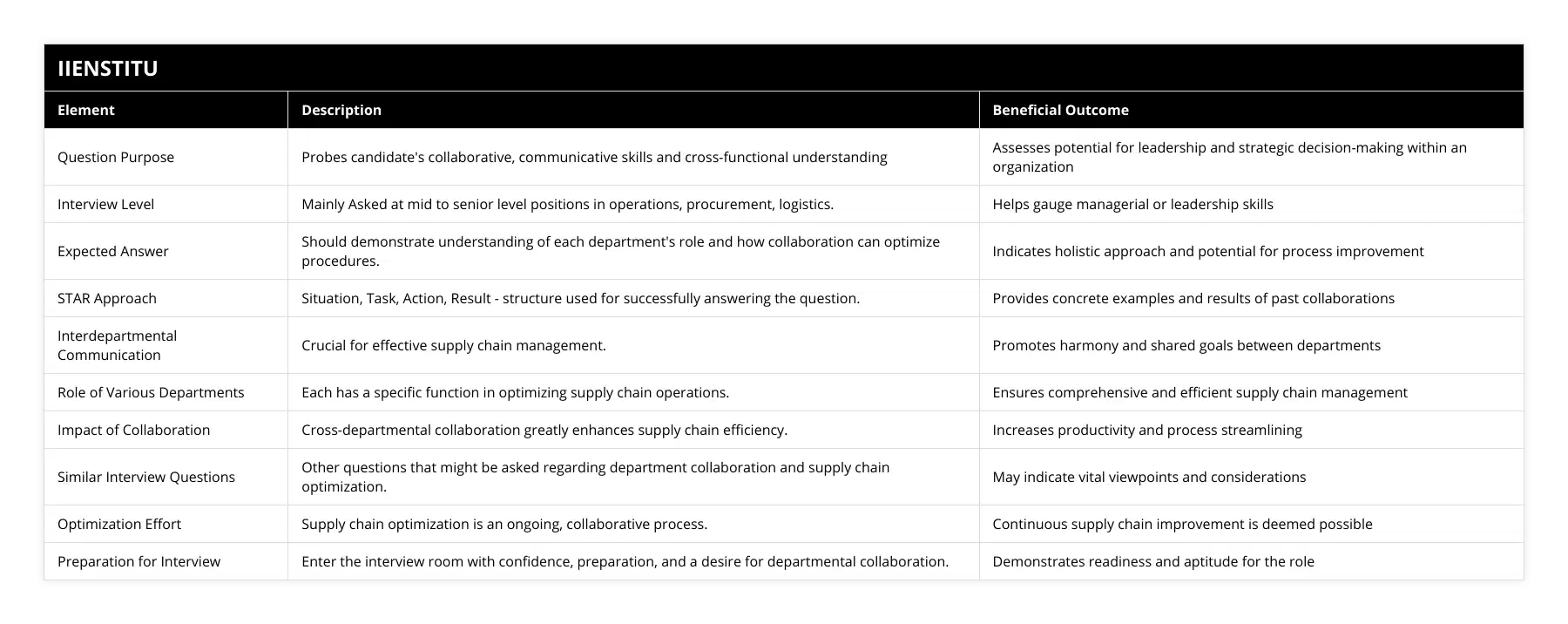
1- Establish clear communication channels: Implement regular cross-functional meetings, shared project management tools, and open lines of communication to ensure that everyone is on the same page.
2- Define shared goals and metrics: Work with each department to identify common objectives and develop a balanced scorecard that reflects the interdependencies between functions.
3- Foster a culture of continuous improvement: Encourage a mindset of learning, experimentation, and innovation, where departments work together to identify and implement new ways of working.
4- Invest in training and development: Provide opportunities for employees to learn about other functions, develop collaborative skills, and build relationships across the organization.
5- Celebrate successes and learn from failures: Recognize and reward successful collaborations, while also using setbacks as opportunities for learning and growth.
By implementing these strategies, organizations can unlock the full potential of their supply chain operations, driving efficiency, agility, and customer satisfaction. As Srinivasan (2019) notes in his book "Supply Chain Management: Principles, Practices, and Applications," "collaboration among supply chain partners is the key to achieving a competitive advantage in today's global marketplace" (p. 243).
Of course, the journey towards effective interdepartmental collaboration is not always easy. It requires a sustained commitment from leadership, a willingness to challenge the status quo, and a recognition that true optimization is an ongoing process. However, for those organizations that embrace the power of collaboration, the rewards can be significant.
In my own experience, I've seen cross-functional teams achieve remarkable results, from reducing inventory levels by 20% to improving on-time delivery rates by over 90%. These improvements not only benefit the supply chain function but also have a ripple effect across the entire organization, driving increased revenue, customer loyalty, and employee engagement.
As we look to the future of supply chain management, it's clear that collaboration will only become more critical. With the rise of digital technologies, the increasing complexity of global networks, and the ever-changing demands of customers, organizations will need to be more agile, responsive, and interconnected than ever before. By building a foundation of trust, communication, and shared purpose, companies can position themselves for success in this dynamic landscape.
In conclusion, collaborating with departments to optimize supply chain is not just a nice-to-have but a business imperative in today's world. It requires a fundamental shift in mindset, from a siloed, functional focus to a holistic, end-to-end perspective. By breaking down barriers, fostering open communication, and working towards common goals, organizations can unlock the full potential of their supply chain operations, driving efficiency, innovation, and growth. As supply chain professionals, it's our responsibility to champion this collaborative approach, to build bridges across functions, and to lead the way towards a more integrated, resilient, and successful future.
References:
Autry, C. W., Bell, J. E., & Moon, M. A. (2015). Creating a collaborative supply chain: A guide for practitioners. Global Supply Chain Institute, University of Tennessee.
Hansen, M. T. (2009). Collaboration: How leaders avoid the traps, create unity, and reap big results. Harvard Business Press.
Srinivasan, R. (2019). Supply chain management: Principles, practices, and applications. Oxford University Press.
Frequently Asked Questions
1. How do you ensure effective communication across different departments in the supply chain?
Effective communication across departments in the supply chain is critical. I have a few key strategies that have worked well for me in past roles:
Establish Clear Channels
I set up regular check-ins with key contacts in each department - procurement, logistics, warehousing, etc. We agree on the best ways to share info, whether it's email, phone, or an internal messaging system. The important thing is that everyone knows how to get in touch.
Collaborative Planning
To keep everyone aligned, I organize cross-functional planning sessions at the start of major initiatives. We gather input from all teams to create integrated project plans. This gets buy-in upfront and surfaces any issues early. I remember one time, a planning meeting helped us avoid a major delay by identifying a capacity constraint in the warehouse.
Shared Goals & Metrics
Establishing shared KPIs that span the end-to-end supply chain motivates collaboration. If we're all held accountable for the same outcomes, it fosters teamwork. I work with leadership to define targets like total cycle time that require all functions to work together.
Bottom line, I believe frequent interaction, shared processes, and aligned incentives are key to bridging silos. It takes effort but pays off in smoother operations. Let me know if you have any other questions!
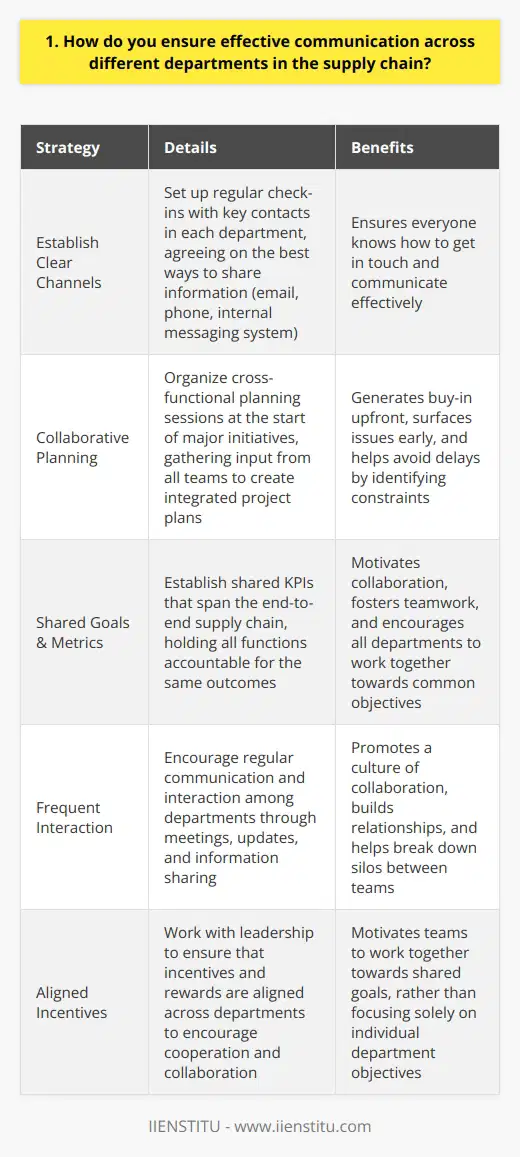
2. What strategies do you employ to align the goals and objectives of various departments?
As a leader, I believe in fostering collaboration and aligning goals across departments. One key strategy I employ is open communication. I regularly meet with department heads to discuss their objectives, challenges, and progress. These meetings provide a platform for sharing insights and finding common ground.
Encouraging Interdepartmental Collaboration
I actively encourage cross-functional collaboration. By creating opportunities for departments to work together on projects, we break down silos and promote a shared vision. For example, in my previous role, I initiated a task force comprising members from marketing, sales, and product development. Together, they developed a unified strategy that boosted customer satisfaction and drove revenue growth.
Setting Clear Priorities and Metrics
To ensure everyone is working towards the same goals, I prioritize setting clear objectives and metrics. I work with each department to define key performance indicators (KPIs) that align with the company's overall strategy. By regularly monitoring and reporting on these KPIs, we can track progress and make data-driven decisions.
Fostering a Culture of Transparency
Transparency is crucial for aligning departments. I believe in openly sharing information, successes, and challenges across the organization. When everyone has access to the same data and insights, it becomes easier to identify areas for collaboration and improvement.
Ultimately, aligning departments requires a combination of effective communication, collaboration, and clear goal-setting. By fostering a culture of transparency and teamwork, we can break down barriers and achieve great things together.

3. How do you foster a collaborative environment among departments to optimize the supply chain?
Throughout my career, I've found that open communication is key to fostering collaboration between departments. I make it a priority to establish clear lines of communication with all stakeholders involved in the supply chain process.
Building Relationships
I invest time in building strong relationships with colleagues from other departments. Getting to know them personally helps break down barriers and encourages teamwork. I often invite them for coffee or lunch to discuss challenges and brainstorm solutions together.
Sharing Information
To optimize the supply chain, it's crucial that everyone has access to the same information. I set up regular cross-functional meetings where we share updates, discuss bottlenecks, and align on goals. This keeps everyone on the same page and working towards a common objective.
I also leverage technology to ensure real-time data is available to all departments. Cloud-based platforms allow us to track inventory levels, shipments, and more - promoting transparency and enabling quick decision-making.
Encouraging Feedback
I believe that the best ideas often come from those closest to the work. That's why I actively seek input from team members across the supply chain. Their insights help identify areas for improvement and drive innovation.
By valuing diverse perspectives and creating a safe space for open dialogue, I've found that people are more willing to collaborate and think outside the box. Some of our most impactful optimizations have come from cross-functional brainstorming sessions!
Leading by Example
Ultimately, fostering a collaborative culture starts with leadership. I strive to model the behavior I want to see in my team. That means being proactive in reaching out to other departments, actively listening to their concerns, and always looking for win-win solutions.
By demonstrating a commitment to collaboration myself, I've found that it inspires others to do the same. Together, we're able to break down silos, streamline processes, and deliver better results for the business.
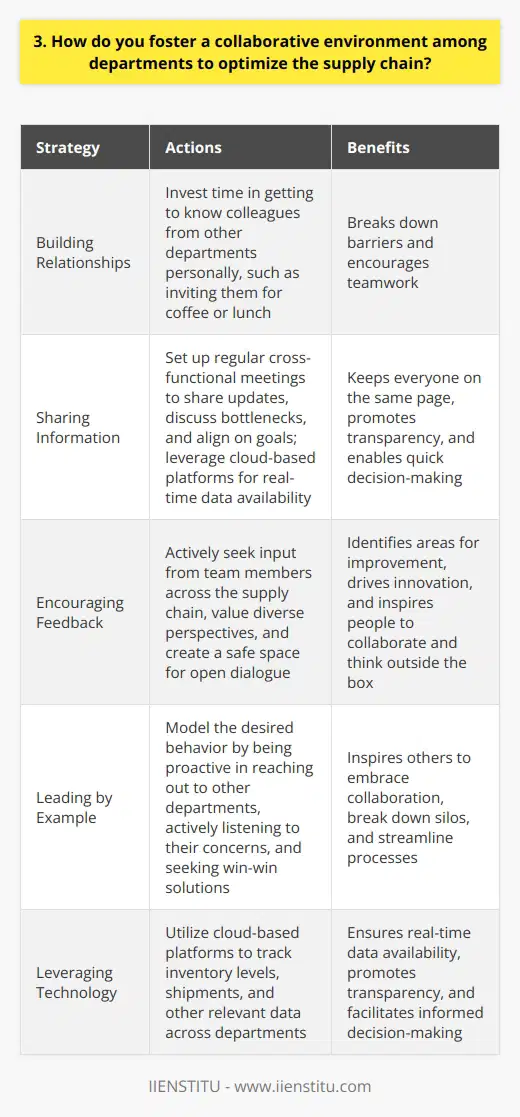
4. Can you describe a time when you successfully collaborated with another department to improve supply chain efficiency?
In my previous role as a supply chain coordinator, I successfully collaborated with the marketing department to improve efficiency. The marketing team expressed frustration with frequent product shortages, which hindered their promotional efforts. I took the initiative to set up a joint meeting between our departments.
Identifying the Root Cause
During the meeting, we openly discussed the challenges faced by both teams. Through active listening and asking targeted questions, I worked to identify the root cause of the supply chain issues. It became clear that there was a lack of communication and synchronization between our departments' planning processes.
Developing a Solution
I proposed implementing a shared forecasting system that would allow real-time visibility into marketing campaigns and promotions. By integrating this data into our supply chain planning, we could better anticipate demand spikes and adjust our inventory levels accordingly. The marketing team enthusiastically agreed to provide regular updates on their upcoming initiatives.
Implementing the Plan
I took the lead in setting up the shared forecasting system and trained both teams on its usage. We established clear communication channels and set up regular cross-functional meetings to review the data and make necessary adjustments. As a result of this collaboration, we significantly reduced product shortages and improved overall supply chain efficiency.
Achieving Positive Results
The marketing department expressed gratitude for the improved availability of products during their campaigns. They were able to execute their promotions without the frustration of stockouts. Our collaboration not only enhanced supply chain performance but also fostered a stronger relationship between the two departments.
This experience taught me the value of proactive communication, empathy, and finding mutually beneficial solutions. I am confident in my ability to collaborate effectively with cross-functional teams to drive continuous improvement in supply chain processes.

5. What challenges have you faced while collaborating with other departments, and how did you overcome them?
Throughout my career, I've worked closely with various departments to achieve common goals. One notable challenge I faced was when our marketing team needed to launch a new product campaign, but the product development team encountered unexpected delays.
Bridging the Communication Gap
I took the initiative to set up regular cross-departmental meetings to foster open communication and collaboration. By bringing everyone together, we were able to identify the root causes of the delays and brainstorm solutions.
Finding Common Ground
Initially, there was some tension between the departments due to differing priorities. I listened actively to each team's concerns and helped them find common ground. We agreed on a revised timeline that accommodated both the product development and marketing needs.
Leveraging Strengths
I recognized that each department brought unique skills and perspectives to the table. I encouraged the teams to leverage their strengths and expertise to overcome the challenges. The marketing team provided valuable insights on customer expectations, while the product development team focused on delivering a high-quality product.
Keeping Everyone Aligned
To ensure everyone stayed aligned throughout the process, I created a shared project dashboard that tracked progress, milestones, and dependencies. This transparency helped build trust and accountability among the teams.
In the end, by fostering open communication, finding common ground, leveraging strengths, and keeping everyone aligned, we successfully launched the product campaign. The experience taught me the importance of collaboration, adaptability, and leadership in driving cross-functional projects forward.
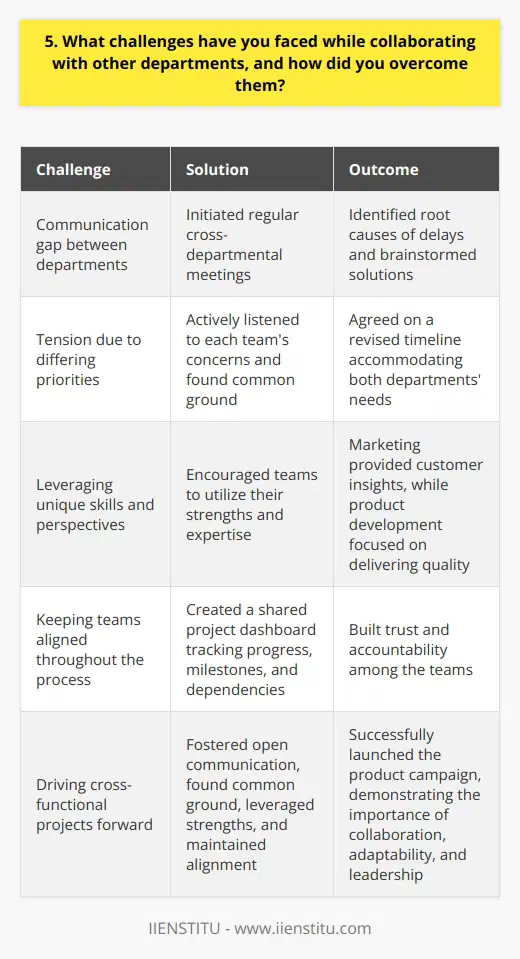
6. How do you prioritize tasks and projects when working with multiple departments simultaneously?
When working with multiple departments simultaneously, I prioritize tasks and projects based on several key factors:
Urgency and Deadlines
I always consider the urgency of each task and the deadlines associated with them. Tasks with tighter deadlines or those that are more time-sensitive naturally take priority.
Impact on Business Goals
I evaluate how each task or project aligns with the overall business goals and objectives. Those that have a more significant impact on achieving these goals are given higher priority.
Dependencies and Bottlenecks
I look for dependencies between tasks and departments. If one task is blocking progress on others, it becomes a top priority to resolve that bottleneck.
Stakeholder Needs
I consider the needs and expectations of various stakeholders involved in each project. I prioritize tasks that are critical for key stakeholders and those that have been escalated by them.
Efficient Resource Allocation
I aim to allocate resources efficiently across departments. I prioritize tasks that can be completed with available resources while minimizing idle time and maximizing productivity.
By considering these factors and maintaining open communication with all departments, I can effectively prioritize and manage multiple tasks and projects simultaneously. It's a balancing act, but with careful planning and coordination, it can be done successfully.
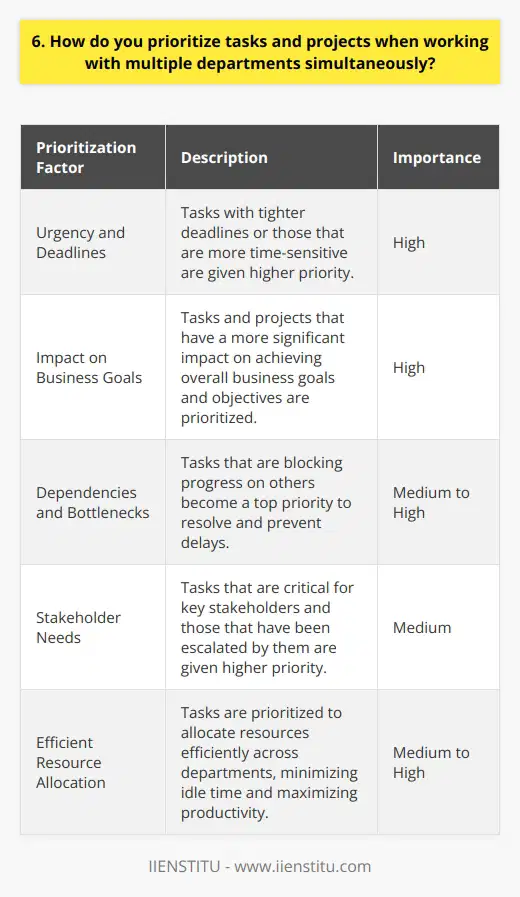
7. What metrics do you use to measure the success of cross-departmental collaboration in the supply chain?
When measuring the success of cross-departmental collaboration in the supply chain, I focus on several key metrics. First and foremost, I look at on-time delivery rates. This indicates how well different departments are working together to meet customer expectations.
Another important metric is inventory accuracy. If departments aren't communicating effectively, discrepancies can crop up between actual and recorded stock levels. Regularly auditing inventory helps catch any issues.
Efficiency Metrics
I also track various efficiency metrics like order processing times, picking accuracy rates, and shipping costs per unit. Improvements in these areas often point to better collaboration and information sharing between procurement, warehousing, and logistics teams.
For example, at my previous company, we noticed order processing was taking too long. After some cross-departmental brainstorming sessions, we developed a new system that reduced processing times by 20%. It was immensely satisfying to see everyone come together to solve the problem.
Qualitative Feedback
Quantitative data tells an important part of the story, but I believe qualitative feedback is equally vital. Regularly surveying employees about communication breakdowns, silos, or other pain points provides valuable insights you can't get from numbers alone.
In my experience, the most successful supply chain operations foster a culture of open dialogue between departments. People feel safe offering suggestions and constructive criticism. When I see this happening, I know interdepartmental collaboration is on the right track.
Ultimately, there's no single metric that perfectly encapsulates cross-departmental collaboration. It's about looking at a constellation of quantitative and qualitative indicators to get the full picture. By monitoring this data mix, I can assess strengths, weaknesses, and opportunities for improvement.
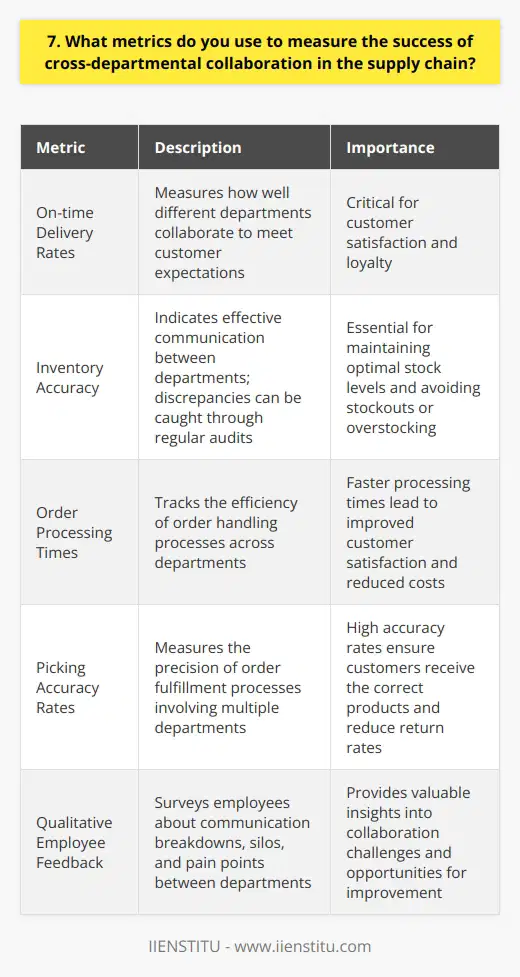
8. How do you handle conflicts or disagreements that may arise during collaborative efforts?
When faced with conflicts or disagreements during collaborative efforts, I believe in addressing them promptly and professionally. I try to actively listen to understand the other person's perspective before expressing my own thoughts. By maintaining an open and respectful dialogue, I find that most issues can be resolved amicably.
Seeking Common Ground
One approach I take is to look for areas of agreement and shared goals. Even if we have differing opinions on how to get there, reminding ourselves of our common objectives can help bridge the gap. I've found that focusing on solutions rather than dwelling on problems keeps the conversation constructive.
Compromising and Collaborating
In some cases, compromising on less critical points can lead to a mutually acceptable resolution. However, for more complex issues, I believe in collaborating to find creative solutions that address everyone's concerns. By brainstorming together and being open to new ideas, I've been part of teams that turned conflicts into opportunities for innovation.
Escalating When Necessary
If, despite our best efforts, the disagreement persists or escalates, I'm not afraid to involve a neutral third party, like a manager or mediator. Sometimes an outside perspective can help break the deadlock and find a way forward.
At the end of the day, I believe that handling conflicts with empathy, respect, and a focus on resolution is key to maintaining healthy collaborative relationships. These experiences have taught me the importance of being a good listener, communicator, and problem-solver.
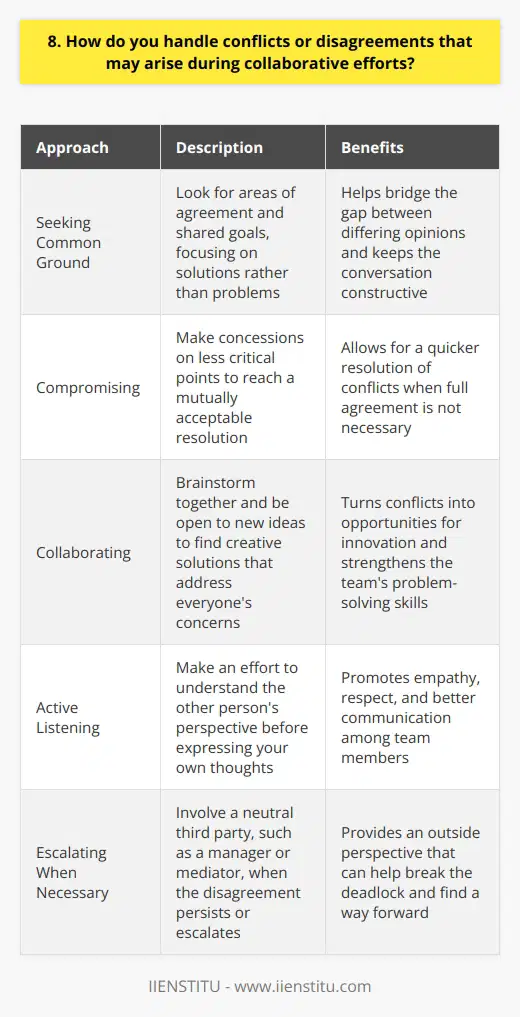
9. Can you explain your experience in leading cross-functional teams to optimize supply chain performance?
Throughout my career, I've had the privilege of leading diverse, cross-functional teams to optimize supply chain performance. One of my most rewarding experiences was at ABC Company, where I spearheaded a project to streamline our logistics processes.
Building a Strong Team
I began by assembling a team of experts from various departments, including procurement, operations, and IT. By fostering open communication and collaboration, we were able to identify key areas for improvement and develop targeted solutions.
Implementing Innovative Solutions
Together, we implemented a new inventory management system that reduced waste and improved efficiency. We also negotiated better contracts with suppliers, resulting in significant cost savings for the company.
Achieving Measurable Results
Through our efforts, we were able to reduce lead times by 20% and increase on-time deliveries to 98%. I'm incredibly proud of what we accomplished as a team and the positive impact it had on the company's bottom line.
Lessons Learned
Leading this project taught me the importance of clear communication, setting shared goals, and leveraging each team member's unique strengths. I believe these experiences have prepared me well for the challenges and opportunities of this role.
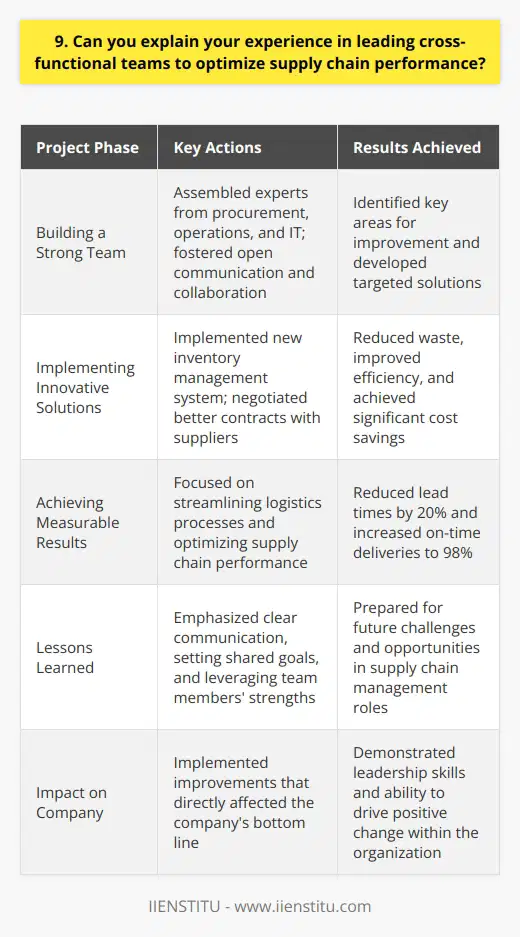
10. What tools or technologies do you utilize to facilitate collaboration among departments?
As a project manager, I rely on several tools and technologies to facilitate collaboration among departments:
Cloud-based project management software
I use platforms like Asana and Trello to create project boards, assign tasks, and track progress. These tools allow team members from different departments to stay informed and aligned on project goals and deadlines.
Video conferencing and instant messaging
Regular video calls via Zoom or Google Meet help keep everyone on the same page. Slack is my go-to for quick questions and updates, reducing the need for lengthy emails.
Collaborative document editing
Google Docs and Sheets enable real-time collaboration on project plans, budgets, and reports. Multiple team members can contribute simultaneously, and changes are automatically saved and synced.
Visual collaboration tools
For brainstorming and ideation sessions, I love using Miro or Mural. These virtual whiteboards allow teams to share ideas, create mind maps, and sketch out concepts together, even when working remotely.
Agile project management methodologies
Implementing agile frameworks like Scrum or Kanban helps break down silos between departments. Regular stand-up meetings, sprint planning, and retrospectives foster transparency, adaptability, and continuous improvement.
In my experience, the key to successful collaboration is combining the right tools with clear communication and a shared sense of purpose. By leveraging these technologies and approaches, I've been able to lead cross-functional teams to deliver exceptional results.
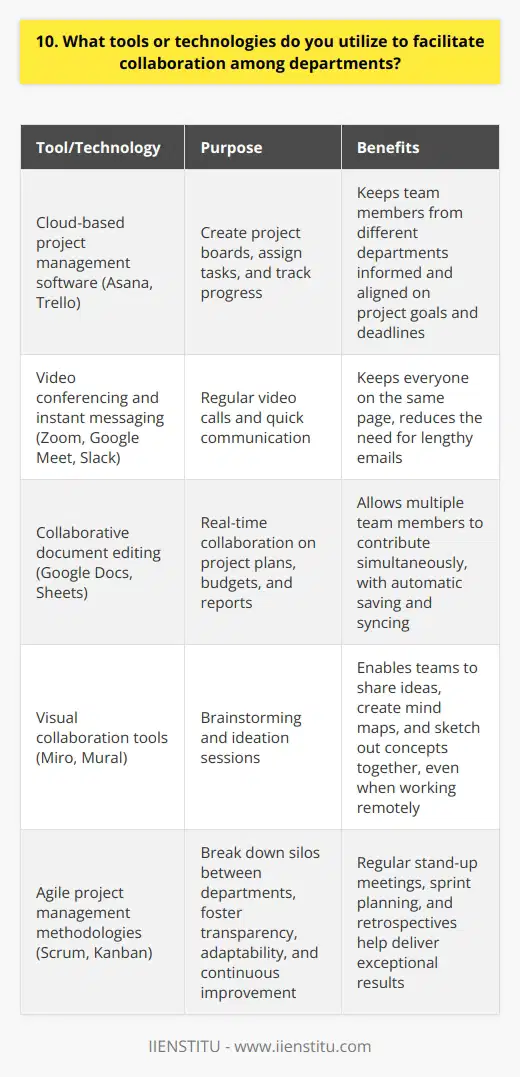
11. How do you ensure that all departments have a clear understanding of their roles and responsibilities in the supply chain?
As a supply chain manager, I believe that clear communication is key to ensuring that all departments understand their roles and responsibilities. I start by creating a detailed Supply Chain Responsibility Matrix that outlines each department's specific tasks and duties. This matrix is shared with all relevant stakeholders and regularly updated as needed.
Regular Cross-Functional Meetings
I also organize regular cross-functional meetings where representatives from each department come together to discuss supply chain issues and challenges. These meetings provide an opportunity for everyone to ask questions, share insights, and align on common goals. By fostering open dialogue and collaboration, we can identify potential bottlenecks or gaps in understanding early on.
Training and Development
In addition, I invest in training and development programs to ensure that all team members have the necessary skills and knowledge to perform their roles effectively. This includes providing ongoing education on supply chain best practices, industry trends, and new technologies. By empowering our people with the right tools and resources, we can drive continuous improvement across the supply chain.
Measuring Performance
Finally, I believe in the power of data and metrics to drive accountability and clarity. I work with each department to establish clear KPIs that align with our overall supply chain goals. By regularly tracking and reporting on these metrics, we can quickly identify areas for improvement and ensure that everyone is working towards the same objectives.
At the end of the day, ensuring clear roles and responsibilities in the supply chain requires a combination of communication, collaboration, and continuous improvement. By taking a proactive approach and involving all stakeholders in the process, we can create a more efficient, effective, and resilient supply chain that delivers value to our customers and our bottom line.
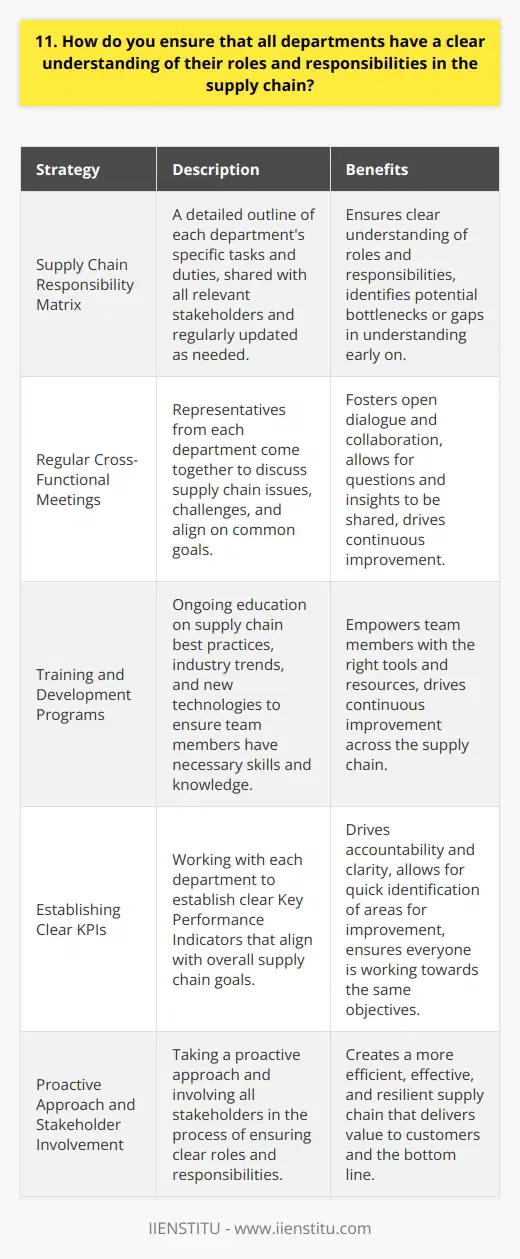
12. What is your approach to building trust and rapport with colleagues from other departments?
Building trust and rapport with colleagues from other departments is crucial for effective collaboration and achieving common goals. My approach is to actively listen to their perspectives and ideas, seeking to understand their priorities and challenges. I believe open and honest communication is key to building strong relationships.
Proactively Reach Out
I make an effort to introduce myself to colleagues from other teams, even if we don't directly work together. Grabbing coffee or lunch together is a great way to get to know each other on a more personal level. Showing genuine interest in their work and experiences helps establish a foundation of trust.
Find Common Ground
When collaborating on projects, I look for shared objectives and values that align our efforts. By highlighting how our goals intersect, it becomes easier to build a sense of camaraderie and purpose. Celebrating milestones and successes together further strengthens the bond between departments.
Be Reliable and Responsive
Consistency is essential for maintaining trust. I strive to follow through on commitments and meet deadlines as promised. If challenges arise, I proactively communicate and work towards finding solutions. Responding promptly to emails and requests shows that I value their time and input.
Seek Feedback and Insights
Regularly soliciting feedback from colleagues demonstrates that I value their opinions and want to improve our working relationship. Their insights help me understand their department's needs and constraints better. By actively addressing any concerns or issues they raise, I show that I'm committed to fostering a positive collaborative environment.

13. How do you stay updated on the latest industry trends and best practices for supply chain collaboration?
I stay updated on the latest industry trends and best practices for supply chain collaboration in several ways:
Attending Industry Conferences and Events
I make it a point to attend at least two major supply chain conferences each year. These events provide valuable insights into emerging trends, technologies, and strategies. I always come away with fresh ideas and perspectives that I can apply in my work.
Participating in Online Forums and Discussion Groups
I'm an active member of several online supply chain communities, including LinkedIn groups and industry-specific forums. These platforms allow me to connect with peers, share experiences, and learn from the collective knowledge of the group. Just last month, I picked up a great tip on streamlining cross-border logistics from a fellow member.
Reading Industry Publications and Blogs
I subscribe to leading supply chain publications and regularly read blog posts from thought leaders in the field. This helps me stay current on the latest research, case studies, and best practices. I often share interesting articles with my team to spark discussions and generate new ideas.
Networking with Peers and Mentors
I believe in the power of building strong professional relationships. I make an effort to connect with colleagues, both within my organization and externally. Having a diverse network allows me to tap into different perspectives and experiences. I often reach out to mentors for guidance on complex challenges.
By combining these approaches, I ensure that I'm always learning and growing as a supply chain professional. Staying updated is not just a task for me; it's a mindset that drives continuous improvement in my work.
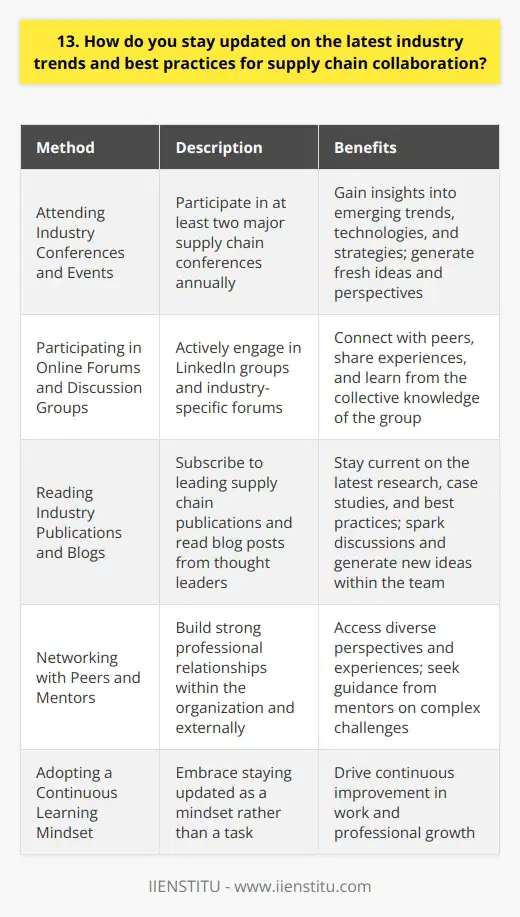
14. Can you provide an example of a creative solution you implemented through collaboration to optimize the supply chain?
In my previous role as a supply chain analyst, I faced a challenge with our inventory management system. Our team struggled to accurately predict demand, leading to frequent stockouts and excess inventory. To address this issue, I collaborated with cross-functional teams to implement a creative solution.
Gathering Insights
I started by reaching out to our sales and marketing teams to gain insights into customer preferences and buying patterns. Through open dialogue and active listening, I discovered valuable information that could help optimize our forecasting models. By fostering strong relationships with these teams, we were able to share knowledge and align our goals.
Developing a Solution
Armed with these insights, I worked closely with our IT department to develop an advanced demand forecasting algorithm. We incorporated machine learning techniques to analyze historical sales data, market trends, and customer behavior. The algorithm could adapt to changing market conditions and provide more accurate demand predictions.
Implementing the Solution
To ensure a smooth implementation, I collaborated with our warehouse managers and logistics partners. We conducted training sessions to familiarize them with the new system and solicited their feedback for continuous improvement. By involving all stakeholders in the process, we fostered a sense of ownership and commitment to the solution's success.
Achieving Results
The implementation of this collaborative solution yielded impressive results. We reduced stockouts by 35% and minimized excess inventory, leading to significant cost savings. Moreover, the improved accuracy of our demand forecasting enabled us to respond more quickly to market changes and customer needs.
This experience taught me the power of collaboration and creative problem-solving in optimizing supply chain operations. By leveraging the expertise of cross-functional teams and embracing innovative technologies, we can drive efficiency and deliver value to our customers.

15. How do you balance the needs and priorities of different departments while maintaining overall supply chain efficiency?
When balancing the needs and priorities of different departments, I always keep the big picture in mind. I start by clearly understanding each department's goals and how they contribute to overall supply chain efficiency. Regular communication is key – I schedule frequent check-ins with department heads to stay aligned.
Prioritizing based on impact
To determine which department's needs to prioritize, I evaluate the potential impact on the entire supply chain. I ask myself, "Which actions will most significantly improve efficiency, reduce costs, or mitigate risks?" By focusing on high-leverage initiatives, I can make the most of limited time and resources.
Encouraging collaboration
In my experience, the best solutions come from collaboration. I facilitate open dialogue between departments to surface creative ideas. Just last month, I organized a cross-functional brainstorming session that generated several promising process improvements. When departments feel heard and valued, they're more willing to make trade-offs for the greater good.
Leveraging data
Data is a powerful tool for finding the right balance. I regularly analyze key supply chain metrics to spot inefficiencies and make informed decisions. For example, if inventory levels are creeping up, I'll work with the purchasing team to adjust order quantities. Hard numbers help align everyone around the most impactful actions.
Ultimately, balancing department needs is an ongoing process that requires flexibility and strong relationships. By keeping the end goal in sight and promoting teamwork, I'm able to optimize the supply chain from end-to-end.
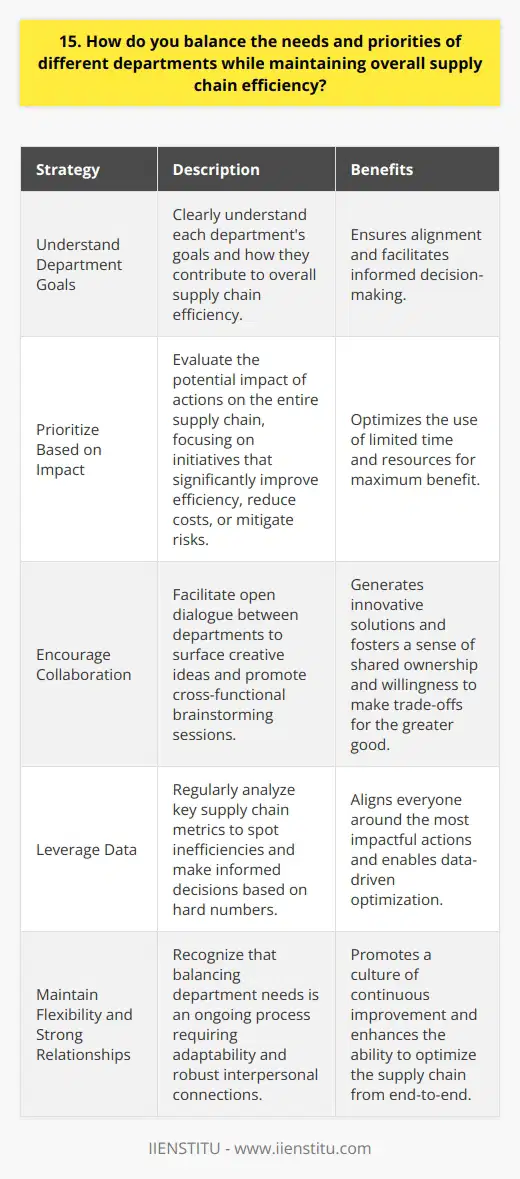
16. What steps do you take to ensure that collaborative efforts are sustainable and can be replicated in the future?
To ensure collaborative efforts are sustainable and replicable, I focus on clear communication and documentation. I establish open lines of communication with all team members, encouraging regular check-ins and updates.
Building Strong Relationships
I invest time in building strong relationships with collaborators. This fosters trust, making it easier to work together effectively. When challenges arise, having that foundation of trust allows us to find solutions more quickly.
Detailed Documentation
Thorough documentation is key to replicating successful collaborations. I make sure to record all processes, decisions, and outcomes. This creates a roadmap that can be followed in the future, even if the original team members are no longer involved.
Continuous Improvement
I'm always looking for ways to improve our collaborative processes. After each project, I gather feedback from the team. We discuss what worked well and identify areas for improvement. This helps us refine our approach over time.
For example, on a recent marketing campaign, we realized our approval process was causing delays. We streamlined it for the next project, which significantly improved our timeline.
Adapting to Change
Collaboration often involves adapting to change, whether it's shifting priorities or unexpected obstacles. I stay flexible and focus on finding creative solutions. By being adaptable, we can keep projects moving forward even when challenges arise.
Ultimately, the key to sustainable collaboration is building strong relationships, documenting processes, and continuously improving. By focusing on these areas, I've been able to lead collaborations that deliver long-term results.

17. How do you identify and address bottlenecks in the supply chain that require cross-departmental collaboration?
To identify bottlenecks in the supply chain, I start by analyzing data from various departments. I look for patterns and anomalies that indicate potential issues. Communication is key when addressing these bottlenecks.
Collaborating with Cross-Functional Teams
I arrange meetings with representatives from different departments to discuss the identified bottlenecks. Together, we brainstorm solutions and develop action plans. I believe in fostering a collaborative environment where everyone's input is valued.
In my previous role, I noticed a significant delay in our product delivery times. After investigating, I discovered that the issue stemmed from a lack of coordination between our procurement and logistics teams. I organized a joint meeting where we mapped out our processes and identified areas for improvement.
Implementing Solutions
Once we have a plan in place, I take the lead in implementing the necessary changes. This may involve updating workflows, training team members, or introducing new tools and technologies. I stay in close communication with all stakeholders to ensure a smooth transition.
In the case of our product delivery delays, we decided to implement a new inventory management system. I worked closely with our IT department to select and integrate the software. We also established clear communication channels between procurement and logistics to prevent future misalignments.
Monitoring and Continuous Improvement
After implementing a solution, I continue to monitor its effectiveness. I track key performance indicators and gather feedback from team members. If necessary, I make adjustments to optimize our processes further.
Thanks to our efforts, we reduced our product delivery times by 25% within three months. However, I didn't stop there. I scheduled regular check-ins with the teams to discuss ongoing challenges and opportunities for improvement. By fostering a culture of continuous improvement, we were able to stay ahead of potential bottlenecks.
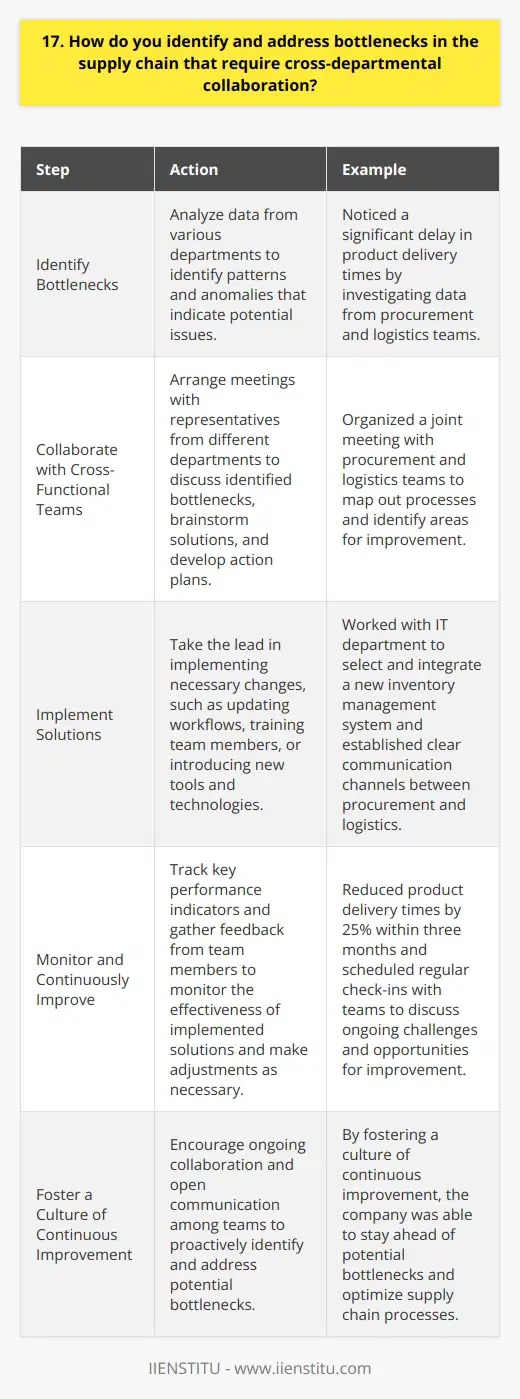
18. What is your experience in collaborating with external partners or suppliers to optimize the supply chain?
Throughout my career, I've had the opportunity to collaborate closely with external partners and suppliers to streamline supply chain processes. I believe that building strong relationships with these stakeholders is key to optimizing the flow of goods and services.
Communicating Clearly and Frequently
One of the most important aspects of collaborating with external partners is maintaining clear, open lines of communication. I make it a point to touch base regularly, whether through email, phone calls, or in-person meetings. By keeping everyone in the loop, we can anticipate potential issues and address them proactively.
Leveraging Technology for Efficiency
I'm also a big believer in using technology to facilitate collaboration and optimize supply chain processes. In my previous role, I worked with our IT team to implement a cloud-based platform that allowed us to share real-time data with our suppliers. This helped us reduce lead times, minimize stockouts, and improve overall efficiency.
Continuously Seeking Opportunities for Improvement
Finally, I'm always looking for ways to improve our supply chain partnerships. I regularly solicit feedback from our suppliers and partners, and I'm not afraid to suggest changes or improvements when necessary. By continuously refining our processes and strengthening our relationships, we can create a more resilient, responsive supply chain.
At the end of the day, collaborating with external partners and suppliers is all about teamwork and communication. By working together towards common goals, we can optimize the supply chain and drive better results for the business.
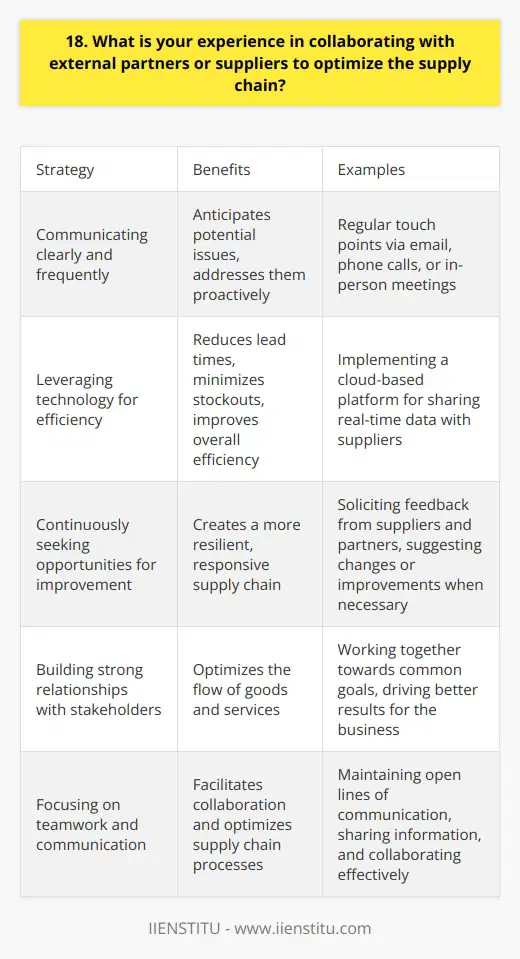
19. How do you foster a culture of continuous improvement and innovation through collaboration?
I believe that fostering a culture of continuous improvement and innovation through collaboration is essential for any organization's success. Here are some ways I strive to achieve this:
Encourage open communication
I make sure to create an environment where everyone feels comfortable sharing their ideas and feedback. Regular team meetings, brainstorming sessions, and one-on-one conversations help facilitate this open dialogue. When people feel heard and valued, they're more likely to contribute their unique perspectives and insights.
Lead by example
As a leader, I believe in modeling the behavior I want to see in my team. I'm always looking for ways to improve processes, try new approaches, and learn from both successes and failures. By demonstrating a growth mindset and willingness to experiment, I inspire my team to do the same.
Celebrate wins and learn from setbacks
When the team achieves a goal or makes a breakthrough, we take time to celebrate and recognize everyone's contributions. However, we also view setbacks as opportunities to learn and grow. We analyze what went wrong, brainstorm solutions, and use those insights to inform future projects.
Foster cross-functional collaboration
Innovation often happens at the intersection of different disciplines and perspectives. I encourage my team to collaborate with colleagues from other departments, share knowledge, and explore new ideas together. This helps break down silos, sparks creativity, and leads to more holistic solutions.
Provide resources and support
To truly foster innovation, it's important to give team members the tools, training, and support they need to succeed. Whether it's access to new technologies, professional development opportunities, or simply the time and space to experiment, I make sure my team has the resources to turn their ideas into reality.
By creating a culture of trust, experimentation, and collaboration, I believe we can unlock the full potential of our team and drive meaningful innovation for the organization.

20. Can you describe a time when you had to collaborate with a department that had conflicting objectives, and how you found a solution?
In my previous role as a marketing coordinator, I had to work closely with the sales department to launch a new product. While our marketing team focused on creating a compelling campaign to generate buzz and attract customers, the sales team prioritized hitting their quarterly targets and wanted to offer deep discounts to move inventory quickly.
Finding Common Ground
To find a solution, I initiated a meeting with the sales manager to understand their perspective and goals. We openly discussed our objectives and found common ground in wanting the product launch to succeed. I listened actively to their concerns and ideas, and we brainstormed ways to align our efforts.
Developing a Collaborative Plan
Together, we developed a plan that balanced our marketing campaign with a limited-time promotional offer. The sales team agreed to provide a moderate discount during the launch period to incentivize early adopters, while still maintaining profit margins. In return, our marketing team created a sense of urgency and exclusivity around the promotion to drive sales.
Achieving Success Through Teamwork
By fostering open communication, mutual understanding, and a willingness to compromise, we successfully launched the product. Our collaborative approach resulted in exceeding our sales targets and generating positive customer feedback. This experience taught me the importance of proactively seeking to understand different perspectives, finding mutually beneficial solutions, and working together towards a shared goal.
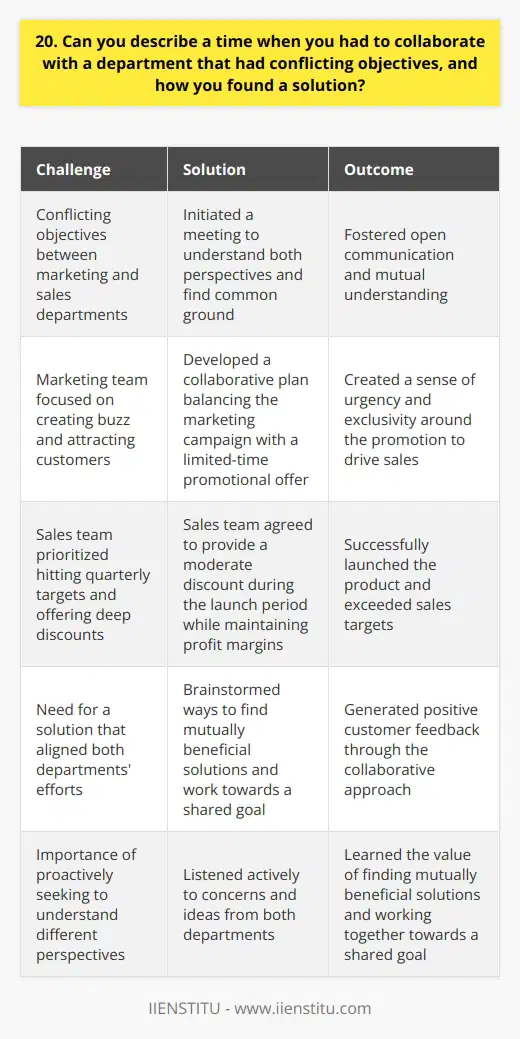
21. What is your approach to managing change and implementing new collaborative processes in the supply chain?
When it comes to managing change and implementing new collaborative processes in the supply chain, I believe in a proactive and inclusive approach. I've found that effective communication is key to getting everyone on board with new initiatives.
Identifying Areas for Improvement
The first step is to carefully analyze the current supply chain processes and identify areas that could benefit from increased collaboration and efficiency. I like to gather input from all stakeholders, from suppliers to end customers, to get a comprehensive view.
Developing a Clear Plan
Once improvement areas are identified, I work on developing a clear, step-by-step plan for implementing changes. The plan should outline roles, responsibilities, timelines, and expected outcomes. I've learned that presenting a well-organized plan helps get buy-in from the team.
Communicating and Collaborating
Throughout the change process, I prioritize open, transparent communication. I schedule regular check-ins with the team to discuss progress, challenges, and ideas. Collaboration is encouraged – some of the best solutions come from brainstorming sessions with diverse perspectives.
Being Adaptable
While having a plan is important, I also remain flexible and open to adjustments along the way. Supply chains can be unpredictable, so being able to adapt quickly is crucial. If something isn't working, I'm not afraid to course-correct.
Measuring Success
Finally, I believe in setting clear metrics to measure the success of new processes. This could include things like reduced lead times, increased order accuracy, or improved customer satisfaction scores. Regularly reviewing these metrics helps determine if the changes are having the desired effect and where further adjustments may be needed.
Overall, my approach is about being proactive, communicative, collaborative, and adaptable. By involving the right people, setting clear goals, and staying flexible, I believe we can successfully navigate change and drive meaningful improvements in the supply chain.
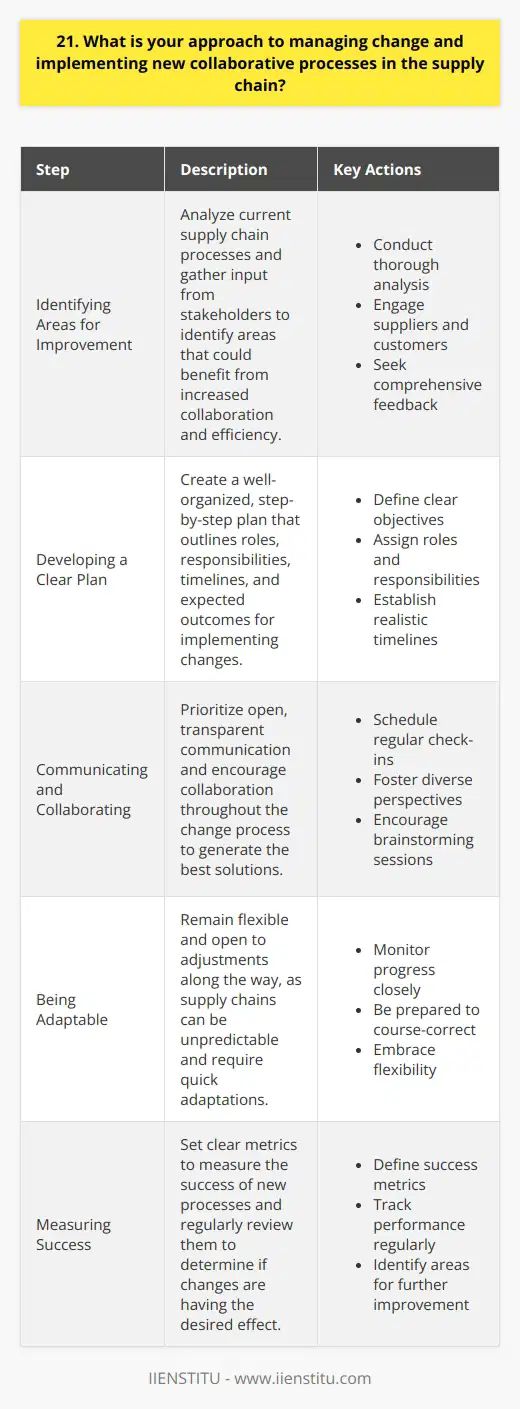
22. How do you ensure that all departments are held accountable for their contributions to the supply chain?
In my experience, effective supply chain management requires close collaboration and accountability across all departments. I believe in establishing clear performance metrics and targets for each team, aligned with overall company goals. Regular cross-functional meetings help ensure everyone understands their role and how it impacts the bigger picture.
Foster Open Communication
I encourage open, honest dialogue between departments. If issues arise, we work together to find solutions. Finger-pointing is counterproductive; instead, I emphasize that we're all on the same team, striving towards mutual success.
Implement Robust Tracking Systems
To hold departments accountable, I implement comprehensive tracking systems. This allows us to monitor progress, identify bottlenecks, and make data-driven decisions. With concrete numbers, it's easier to have productive conversations about areas for improvement.
Celebrate Successes Together
When departments exceed expectations, I make sure to recognize and celebrate those wins. Acknowledging strong performance boosts morale and motivation. It reinforces that every person's contributions matter in keeping our supply chain running smoothly.
At the end of the day, accountability stems from a culture of ownership, collaboration, and continuous improvement. By creating an environment where everyone feels invested in our shared success, departments naturally hold themselves and each other accountable.
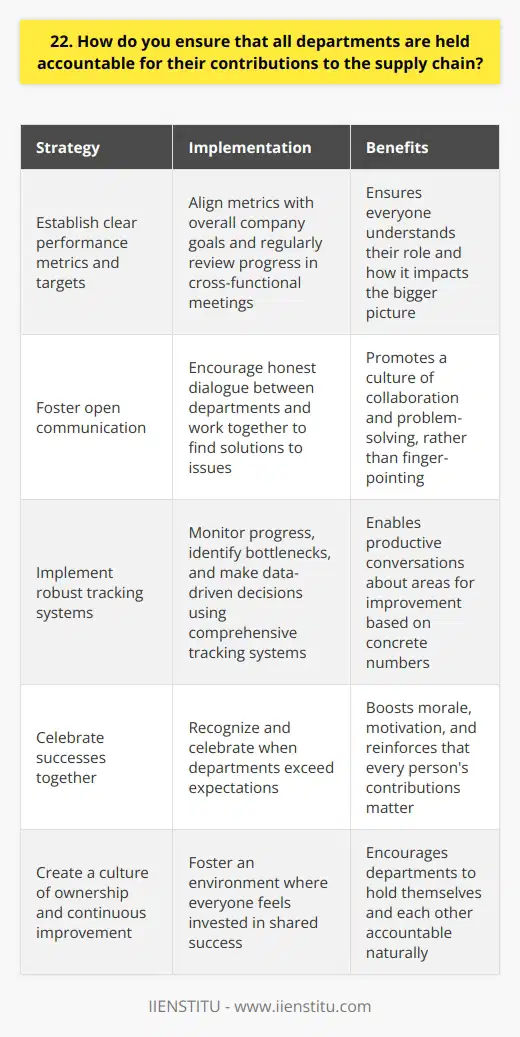
23. What methods do you use to gather and incorporate feedback from different departments to improve collaboration?
As a team player, I believe in the power of collaboration and open communication across departments. I actively seek feedback from colleagues to identify areas where we can work together more effectively.
Fostering Open Dialogue
I make a point to have regular check-ins with members of other teams. During these conversations, I ask for their honest input on how our departments can better support each other's goals and workflows. By creating a safe space for sharing ideas, I've found that people are more willing to open up about challenges and brainstorm solutions together.
Conducting Surveys and Polls
To gather broader insights, I occasionally send out brief surveys or polls. These allow me to quickly gauge overall sentiment and collect suggestions from a wider audience. The anonymity often encourages people to share feedback they might hesitate to voice in person.
Analyzing Data and Metrics
I also look at hard data and performance metrics to spot trends or bottlenecks in cross-functional processes. If I notice an area where collaboration seems to break down frequently, I dig deeper to pinpoint the root causes. Armed with those insights, I can propose targeted solutions to smooth out the workflow.
Implementing Feedback
Of course, gathering feedback is just the first step. The key is acting on it! I always circle back with stakeholders to discuss key takeaways and develop an action plan. By demonstrating that I value their input and am committed to continuous improvement, I strengthen buy-in and rapport. It's incredibly rewarding to see how small tweaks in communication and processes can yield major gains in productivity and team synergy.
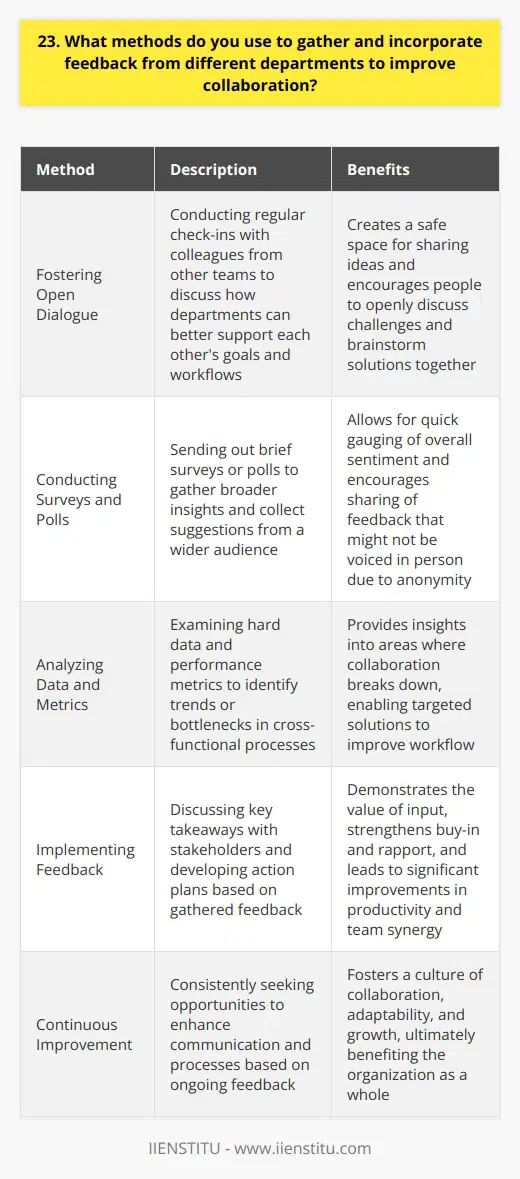
24. How do you prioritize collaboration efforts based on their potential impact on supply chain performance?
When prioritizing collaboration efforts based on their potential impact on supply chain performance, I first assess the urgency and importance of each initiative. I consider how each effort aligns with our overall supply chain strategy and goals. This helps me determine which collaborations will yield the greatest benefits for our organization.
Analyzing Data and Metrics
To make informed decisions, I analyze key supply chain metrics and data. I look at factors such as lead times, inventory levels, and customer satisfaction scores. By identifying areas where collaboration can drive significant improvements, I can prioritize efforts effectively.
Engaging Cross-Functional Teams
Collaboration often involves working with cross-functional teams. I engage stakeholders from various departments to gain insights into their challenges and requirements. By fostering open communication and building strong relationships, I can ensure that collaboration efforts are well-coordinated and aligned with business objectives.
Balancing Short-Term and Long-Term Impact
When prioritizing collaboration efforts, I strive to balance short-term gains with long-term strategic impact. While some initiatives may yield quick wins, others may require more time and resources but offer significant benefits in the long run. I carefully evaluate the trade-offs and make decisions that optimize overall supply chain performance.
Continuously Monitoring and Adjusting
Prioritizing collaboration efforts is an ongoing process. I continuously monitor the progress and impact of each initiative. If an effort is not delivering the expected results, I'm not afraid to make adjustments or reallocate resources. By being adaptable and responsive, I can ensure that collaboration efforts remain focused on driving supply chain excellence.
In my experience, effective prioritization of collaboration efforts requires a combination of strategic thinking, data-driven decision-making, and strong communication skills. By aligning efforts with business goals, engaging the right stakeholders, and continuously monitoring progress, I can maximize the impact of collaboration on supply chain performance.

25. Can you explain how you use data and analytics to drive collaborative decision-making in the supply chain?
In my experience, leveraging data and analytics is crucial for driving collaborative decision-making in the supply chain. I believe in using a combination of quantitative and qualitative data to gain comprehensive insights.
Gathering and Analyzing Data
I start by gathering relevant data from various sources, such as ERP systems, supplier performance metrics, and market trends. Then, I analyze this data using statistical tools and techniques to identify patterns and trends.
For example, at my previous company, I used historical sales data to forecast demand for the upcoming quarter. This helped us optimize inventory levels and reduce waste.
Collaborating with Stakeholders
Once I have analyzed the data, I share my findings with key stakeholders across the supply chain. I facilitate open discussions to gather their perspectives and insights.
I remember a time when I worked closely with our procurement team to evaluate supplier performance. By combining data analysis with their on-the-ground knowledge, we identified areas for improvement and negotiated better contracts.
Making Data-Driven Decisions
Armed with data and stakeholder input, I guide the team towards making informed, collaborative decisions. I believe in considering both the numbers and the human factors involved.
In one instance, our data showed that a particular shipping route was causing delays. However, after discussing with the logistics team, we realized that an alternative route would significantly increase costs. We found a middle ground that balanced efficiency and cost-effectiveness.
Continuous Improvement
I don't stop at just making decisions; I continuously monitor and assess the outcomes. I use data to track the impact of our choices and identify areas for further improvement.
By consistently leveraging data and analytics, I have been able to drive collaborative decision-making that optimizes our supply chain performance. It's an approach I'm passionate about and have seen deliver results time and again.
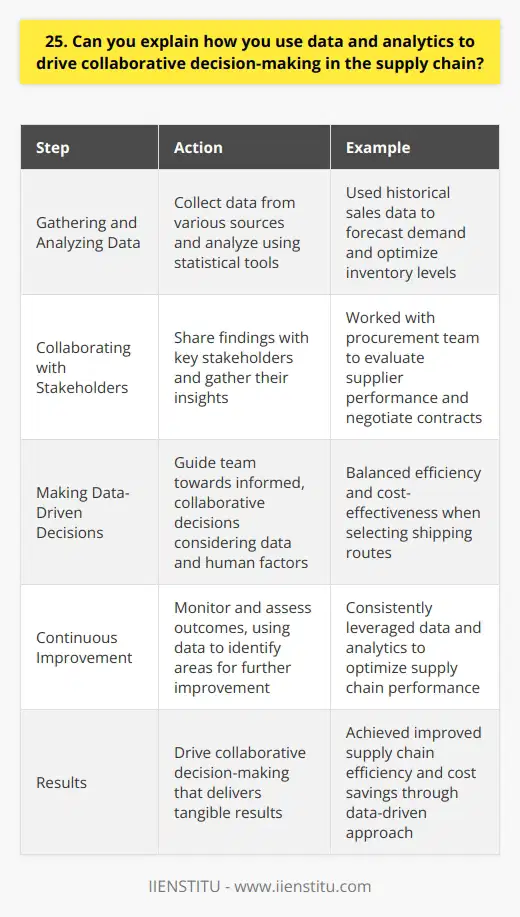
26. What is your experience in collaborating with international teams or departments to optimize global supply chains?
Throughout my career, I've had the privilege of working with international teams to optimize global supply chains. One of my most memorable experiences was when I collaborated with our European and Asian offices to streamline our logistics processes.
Building Strong Relationships
I believe that building strong relationships is key to successful international collaboration. I made sure to schedule regular video calls with my colleagues abroad to foster open communication and trust. We took the time to understand each other's challenges and brainstorm solutions together.
Leveraging Technology
To optimize our global supply chain, we leveraged cutting-edge technology. I worked closely with our IT department to implement a cloud-based inventory management system that provided real-time visibility across all our warehouses worldwide. This allowed us to make data-driven decisions and quickly adapt to changes in demand.
Continuous Improvement
I'm a big believer in continuous improvement. After implementing the new inventory management system, I led a project to analyze our supply chain performance and identify areas for optimization. We conducted a thorough review of our transportation routes, warehouse locations, and supplier relationships. By making strategic adjustments, we were able to reduce costs and improve delivery times for our global customers.
Collaborating with international teams has been one of the most rewarding aspects of my career. I've learned so much from working with people from different cultures and backgrounds. It's incredible what we can achieve when we come together with a shared goal and a willingness to think outside the box.
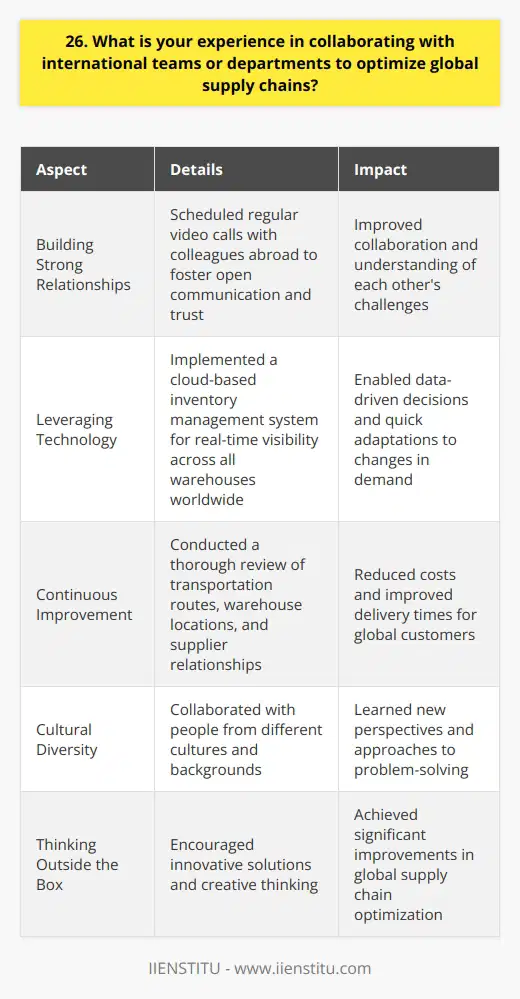
27. How do you ensure that collaborative efforts are aligned with the overall business strategy and goals?
To ensure collaborative efforts align with business strategy and goals, I follow a few key practices:
Understand the Big Picture
I make sure to thoroughly understand the company's overall mission, values, and objectives. This helps guide my decision-making and priorities when working on team projects.
Communicate Early and Often
I check in frequently with managers and stakeholders to confirm we're on the right track. Open communication keeps everyone aligned.
Set Clear Goals and Metrics
For each project, I work with the team to define specific, measurable goals that support the larger strategy. We decide on KPIs to track our progress.
Stay Agile and Adaptable
Business needs can evolve quickly. I stay flexible to adjust plans as needed to keep us moving in the right direction.
Celebrate Successes Along the Way
I find it motivating to acknowledge milestones, both big and small. Sharing wins keeps the team engaged and connected to our larger purpose.
By following these practices, I'm able to keep my collaborations aligned with the company's overall roadmap. It's rewarding to see how our work directly contributes to the organization's success.
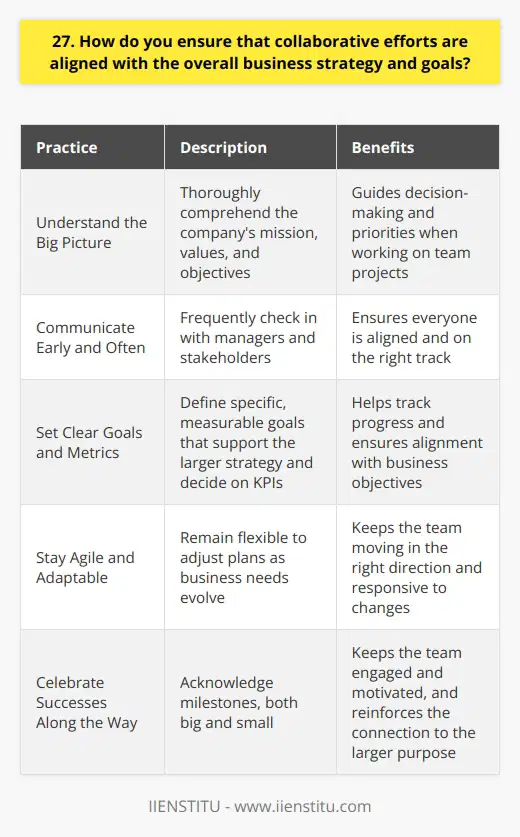
28. What steps do you take to celebrate and recognize successful collaborations among departments?
I believe in celebrating successful collaborations among departments through recognition, communication, and team-building activities. When a cross-departmental project achieves its goals, I make sure to acknowledge the hard work and dedication of everyone involved.
Recognizing Individual Contributions
I take the time to personally thank each team member for their specific contributions. Whether it's through a heartfelt email, a shout-out during a meeting, or a small token of appreciation, I want them to know their efforts are valued.
Sharing Success Stories
To inspire future collaborations, I share success stories throughout the organization. I might write a blog post highlighting the project's challenges and triumphs, or present the case study at a company-wide gathering. By showcasing what's possible when departments work together, we encourage more cross-functional initiatives.
Fostering Team Unity
Celebrating success is also about strengthening the bonds between team members. I like to organize informal gatherings, like a lunch outing or happy hour, where people can relax and connect on a personal level. These moments of camaraderie lay the foundation for even better collaborations in the future.
At the end of the day, it's all about showing genuine appreciation and creating a culture that values teamwork across departmental lines. When we celebrate our wins together, we're motivated to keep pushing forward and achieving great things as one united company.
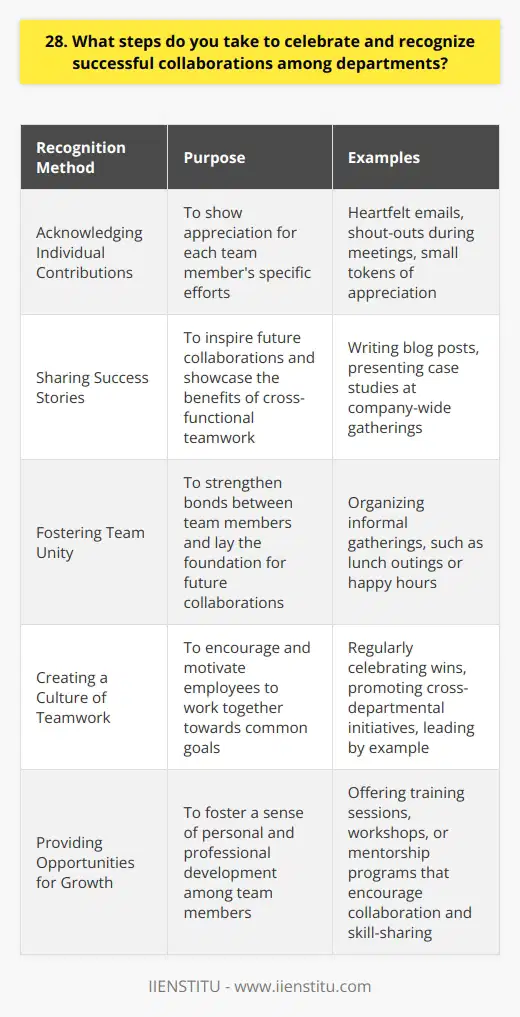
29. How do you foster a sense of shared ownership and responsibility for supply chain performance across departments?
I believe that fostering a sense of shared ownership and responsibility for supply chain performance across departments is crucial. It starts with clear communication and setting common goals that align with the company's overall objectives. Regular cross-functional meetings and collaboration sessions help break down silos and encourage teamwork.
Lead by Example
As a manager, I strive to lead by example and demonstrate the importance of supply chain performance. I actively engage with other departments, seek their input, and show genuine interest in their challenges and successes. By walking the talk, I inspire my team to do the same and take ownership of their roles.
Celebrate Successes Together
When we achieve supply chain milestones or overcome obstacles, I make sure to acknowledge and celebrate the contributions of all departments involved. Sharing the wins and recognizing everyone's efforts reinforces the idea that we are all in this together. It boosts morale and motivates people to continue collaborating towards common goals.
Encourage Cross-Functional Learning
I encourage my team members to spend time shadowing colleagues from other departments and learning about their roles and challenges. This cross-functional exposure helps them understand the bigger picture and how their actions impact others. It fosters empathy, respect, and a sense of shared responsibility for the entire supply chain.
In my experience, when people feel valued, included, and motivated, they naturally take ownership of their work. By promoting a culture of collaboration, communication, and shared goals, I have seen teams come together and drive exceptional supply chain performance.
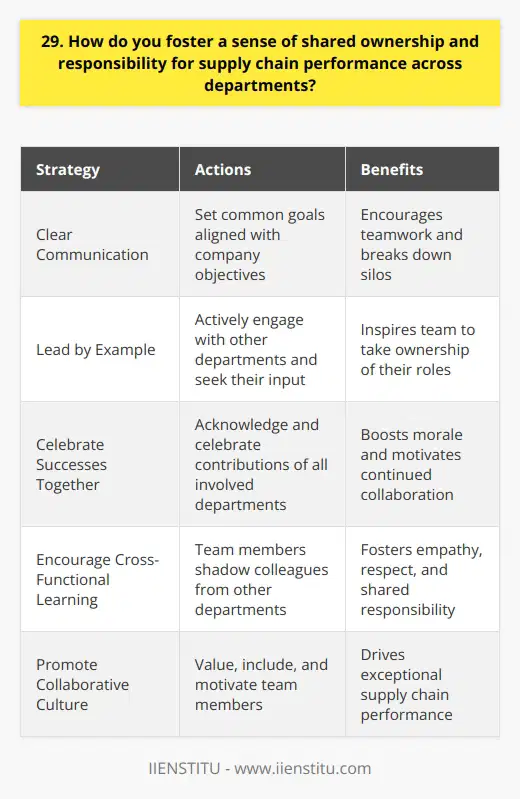
30. Can you describe a time when collaboration with another department led to a significant cost reduction or efficiency improvement in the supply chain?
In my previous role as a supply chain analyst, I collaborated closely with the manufacturing department to streamline our processes. Through regular meetings and open communication, we identified areas where we could reduce waste and improve efficiency.
Identifying Opportunities for Improvement
Together, we conducted a thorough analysis of our supply chain, from raw material procurement to finished product delivery. We discovered that we were holding excess inventory, leading to increased storage costs and longer lead times.
Implementing Just-in-Time Inventory Management
To address this issue, we implemented a just-in-time inventory management system. By working with our suppliers to receive smaller, more frequent deliveries, we reduced our inventory holding costs by 30%.
Optimizing Production Scheduling
Additionally, we optimized our production scheduling to minimize changeover times and reduce idle machine hours. This allowed us to increase our production capacity without additional investments in equipment.
Continuous Improvement and Communication
Throughout the process, we maintained open lines of communication and regularly shared progress updates with stakeholders. This collaboration fostered a culture of continuous improvement and helped us achieve our cost reduction and efficiency goals.
The success of this project demonstrated the power of cross-functional collaboration in driving supply chain improvements. I'm proud of the results we achieved and the strong relationships we built along the way.
